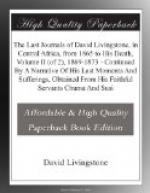Mohamad sowed rice yesterday, and has to send his people (who were unsuccessful among the Balegga) away to the Metambe, where they got ivory before.
I cannot understand very well what a “Theoretical Discoverer” is. If anyone got up and declared in a public meeting that he was the theoretical discoverer of the philosopher’s stone, or of perpetual motion for watches, should we not mark him as a little wrong in the head? So of the Nile sources. The Portuguese crossed the Chambeze some seventy years before I did, but to them it was a branch of the Zambezi and nothing more. Cooley put it down as the New Zambesi, and made it run backwards, up-hill, between 3000 and 4000 feet! I was misled by the similarity of names and a map, to think it the eastern branch of the Zambezi. I was told that it formed a large water in the south-west, this I readily believed to be the Liambai, in the Barotse Valley, and it took me eighteen months of toil to come back again to the Chambeze in Lake Bangweolo, and work out the error into which I was led—twenty-two months elapsed ere I got back to the point whence I set out to explore Chambeze, Bangweolo, Luapula, Moero, and Lualaba. I spent two full years at this work, and the Chief Casembe was the first to throw light on the subject by saying, “It is the same water here as in the Chambeze, the same in Moero and Lualaba, and one piece of water is just like another. Will you draw out calico from it that you wish to see it? As your chief desired you to see Bangweolo, go to it, and if in going north you see a travelling party, join it; if not, come back to me, and I will send you safely by my path along Moero.”
The central Lualaba I would fain call the Lake River Webb; the western, the Lake River Young. The Lufira and Lualaba West form a Lake, the native name of which, “Chibungo,” must give way to Lake Lincoln. I wish to name the fountain of the Liambai or Upper Zambesi, Palmerston Fountain, and adding that of Sir Bartle Frere to the fountain of Lufira, three names of men who have done more to abolish slavery and the slave-trade than any of their contemporaries.
[Through the courtesy of the Earl of Derby we are able to insert a paragraph here which occurs in a despatch written to Her Majesty’s Foreign Office by Dr. Livingstone a few weeks before his death. He treats more fully in it upon the different names that he gave to the most important rivers and lakes which he discovered, and we see how he cherished to the last the fond memory of old well-tried friendships, and the great examples of men like President Lincoln and Lord Palmerston.]
“I have tried to honour the name of the good Lord Palmerston, in fond remembrance of his long and unwearied labour for the abolition of the Slave Trade; and I venture to place the name of the good and noble Lincoln on the Lake, in gratitude to him who gave freedom to 4,000,000 of slaves. These two great men are no longer among us; but it pleases me, here in the wilds, to place, as it were, my poor little garland of love on their tombs. Sir Bartle Frere having accomplished the grand work of abolishing slavery in Scindiah, Upper India, deserves the gratitude of every lover of human kind.




